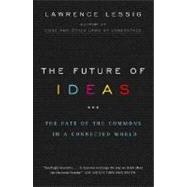
Note: Supplemental materials are not guaranteed with Rental or Used book purchases.
Purchase Benefits
What is included with this book?
| Preface | |
| "Free" | p. 3 |
| Dot.Commons | p. 17 |
| Building Blocks: "Commons" and "Layers" | p. 19 |
| The Commons | p. 19 |
| Layers | p. 23 |
| Commons on the Wires | p. 26 |
| Commons Among the Wired | p. 49 |
| Commons, Wire-less | p. 73 |
| Commons Lessons | p. 85 |
| Dot.Contrast | p. 101 |
| Creativity in Real Space | p. 103 |
| Creativity in the Dark Ages | p. 104 |
| The Arts | p. 104 |
| Commerce | p. 112 |
| Innovation from the Internet | p. 120 |
| New Products from the Net | p. 122 |
| HTML Books | p. 122 |
| MP3 | p. 123 |
| Film | p. 124 |
| Lyric Servers and Culture Databases | p. 124 |
| New Markets | p. 126 |
| New Means of Distribution | p. 126 |
| My.MP3 | p. 127 |
| Napster | p. 130 |
| New Demand | p. 132 |
| New Participation: P2P | p. 134 |
| Dot.Control | p. 143 |
| Old vs. New | p. 145 |
| Controlling the Wires (and Hence the Code Layer) | p. 147 |
| The End-to-End in Telephones | p. 149 |
| Fat Pipe | p. 151 |
| ATandT Cable | p. 153 |
| Controlling the Wired (and Hence the Content Layer) | p. 177 |
| Increasing Control | p. 180 |
| Copyright Bots | p. 180 |
| CPHack | p. 184 |
| DeCSS | p. 187 |
| iCraveTV | p. 190 |
| MP3 | p. 192 |
| Napster | p. 194 |
| Eldred | p. 196 |
| Consequences of Control | p. 199 |
| Controlling Wire-less (and Hence the Physical Layer) | p. 218 |
| What's Happening Here? | p. 234 |
| Alt. Commons | p. 240 |
| The Physical Layer | p. 240 |
| Free Spectrum | p. 241 |
| Free Highways | p. 244 |
| The Code Layer | p. 246 |
| Neutral Platforms | p. 246 |
| The Content Layer | p. 249 |
| Copyright | p. 250 |
| Patents | p. 259 |
| What Orrin Understands | p. 262 |
| Notes | p. 269 |
| Index | p. 335 |
| Table of Contents provided by Blackwell. All Rights Reserved. |
The New copy of this book will include any supplemental materials advertised. Please check the title of the book to determine if it should include any access cards, study guides, lab manuals, CDs, etc.
The Used, Rental and eBook copies of this book are not guaranteed to include any supplemental materials. Typically, only the book itself is included. This is true even if the title states it includes any access cards, study guides, lab manuals, CDs, etc.
Excerpted from The Future of Ideas: The Fate of the Commons in a Connected World by Lawrence Lessig
All rights reserved by the original copyright owners. Excerpts are provided for display purposes only and may not be reproduced, reprinted or distributed without the written permission of the publisher.